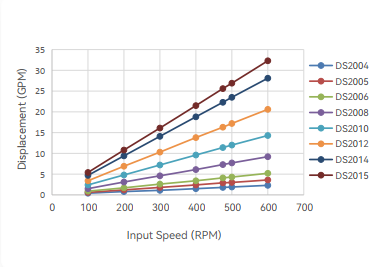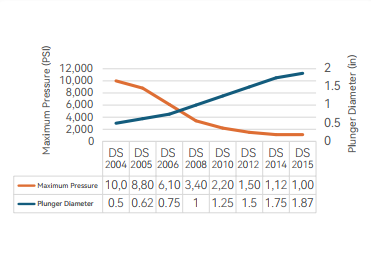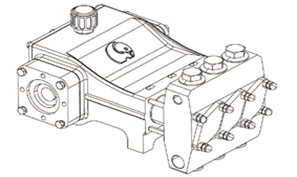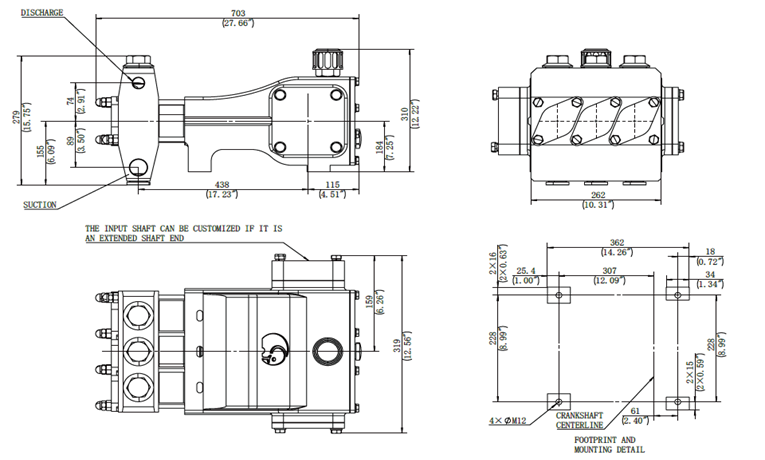Model :
DS-20Type :
Plunger PumpStroke :
1.5 Inches/38.1mmCylinder Diameter :
13-48mmFlow :
1.5-122.3LPM/0.4-32.3GPMPressure :
7-69MPaShipping Port :
Shanghai Port, ChinaWarranty :
12 MonthsSpecifications:
| Design Standard | API-674, Third Edition |
| Configuration | Horizontal Triplex Plunger |
| Number of Plungers | 3 |
| Continuous Duty | 16.6 BHP |
| Intermittent Duty | 20.9 BHP |
| Stroke Length | 1.5 Inches/38.1mm |
| Frame Load Rating | 2,700 lbs/1244.7kg |
| Pump Weight (Average) | 245 lbs/111.13kg |
| Intermittent Duty Speed Rating | 600 RPM |
| Continuous Duty Speed Rating | 475 RPM |
| Minimum Speed | 100 RPM |
| Mechanical Efficiency | 90% |
| Lubrication System | Splash, Gravity Return |
| Lubrication System (Optional) | Pressurized |
| Crankcase Oil Capacity | 2 Gallons/7.57L |
| Lube Oil Type | SAE 30 |
| Fluid Temperature Range | -20 to 350 °F /-28~176°C |
| Valve Type | Disc Valve / Wear-resistant Valve |
Performance Data (Metric):
| Pump Model |
Plunger Diameter (mm) |
Displacement (L/REV) |
Maximum Pressure (MPa) |
Pump Capacity (LPM)@Input Speed (RPM) | ||||||
| 100 | 200 | 300 | 400 | 475 | 500 | 600 | ||||
| DS2004 | 13 | 0.0144 | 69 | 1.5 | 3.0 | 4.2 | 5.7 | 6.8 | 7.2 | 8.7 |
| DS2005 | 16 | 0.0227 | 61 | 2.3 | 4.5 | 6.8 | 9.1 | 11.0 | 11.4 | 13.6 |
| DS2006 | 19 | 0.0326 | 42 | 3.4 | 6.4 | 9.8 | 12.9 | 15.5 | 16.3 | 19.7 |
| DS2008 | 25 | 0.0579 | 23 | 5.7 | 11.7 | 17.4 | 23.1 | 27.6 | 29.1 | 34.8 |
| DS2010 | 32 | 0.0905 | 15 | 9.1 | 18.2 | 27.3 | 36.3 | 43.1 | 45.4 | 54.1 |
| DS2012 | 38 | 0.1302 | 10 | 12.9 | 26.1 | 39.0 | 52.2 | 61.7 | 65.1 | 78.0 |
| DS2014 | 44 | 0.1775 | 8 | 17.8 | 35.6 | 53.4 | 71.2 | 84.4 | 88.9 | 106.4 |
| DS2015 | 48 | 0.2036 | 7 | 20.4 | 40.9 | 60.9 | 81.4 | 96.9 | 101.8 | 122.3 |
Performance Data:
| Pump Model |
Plunger Diameter (in) |
Displacement (GAL/REV) |
Maximum Pressure (PSI) |
Pump Capacity (GPM)@Input Speed (RPM) | ||||||
| 100 | 200 | 300 | 400 | 475 | 500 | 600 | ||||
| DS2004 | 0.5 | 0.0038 | 10,000 | 0.4 | 0.8 | 1.1 | 1.5 | 1.8 | 1.9 | 2.3 |
| DS2005 | 0.625 | 0.006 | 8,800 | 0.6 | 1.2 | 1.8 | 2.4 | 2.9 | 3 | 3.6 |
| DS2006 | 0.75 | 0.0086 | 6,100 | 0.9 | 1.7 | 2.6 | 3.4 | 4.1 | 4.3 | 5.2 |
| DS2008 | 1 | 0.0153 | 3,400 | 1.5 | 3.1 | 4.6 | 6.1 | 7.3 | 7.7 | 9.2 |
| DS2010 | 1.25 | 0.0239 | 2,200 | 2.4 | 4.8 | 7.2 | 9.6 | 11.4 | 12 | 14.3 |
| DS2012 | 1.5 | 0.0344 | 1,500 | 3.4 | 6.9 | 10.3 | 13.8 | 16.3 | 17.2 | 20.6 |
| DS2014 | 1.75 | 0.0469 | 1,120 | 4.7 | 9.4 | 14.1 | 18.8 | 22.3 | 23.5 | 28.1 |
| DS2015 | 1.875 | 0.0538 | 1,000 | 5.4 | 10.8 | 16.1 | 21.5 | 25.6 | 26.9 | 32.3 |
Standard connection sizes:
| Pump Model | Suction (in) | Discharge (in) |
| DS2004-DS2007 | 1.5 | 0.75 |
| DS2008-DS2015 | 1.5 | 1.0 |
| DS2008-DS2015 | 2.0 | 1.5 |
Fluid cylinder materials:
| Fluid cylinder materials | Cast |
| Carbon Steel | Ductile Iron |
| Fluid cylinder materials | |
| 304 / 316L / 17-4PH / 2205 / 2507 Stainless Steel |


Engineering dimensional outline


FAQ
1. What is a Reverse Osmosis Pump? What is its main purpose?
The reverse osmosis pump is a specialized device designed for reverse osmosis water purification systems. As a type of high pressure pump, its primary function is to enhance filtration efficiency by increasing water pressure. In practical applications, this pump significantly enhances the performance of water purification systems, ensuring the treated water meets the desired quality standards. To accommodate diverse operational requirements, reverse osmosis pumps typically feature multiple operating modes and pressure adjustment capabilities, enabling adaptation to various water conditions and system configurations. Furthermore, its high energy efficiency ratio and stable operational performance make it an indispensable key component in modern water purification technology.
2. Why does an RO system need this pump?
Because the reverse osmosis process requires overcoming water's natural tendency to permeate, the system must provide sufficient pressure to reverse this process. Under natural conditions, water permeates from areas of low solute concentration to areas of high solute concentration. Reverse osmosis, however, forces water to move from areas of high solute concentration to areas of low solute concentration, necessitating the use of high-pressure pumps to achieve this. Without such pumps, water molecules cannot effectively pass through the reverse osmosis membrane, rendering the water purification system inoperable. Furthermore, due to significant variations in water quality across different sources, the pressure regulation function of reverse osmosis pumps is particularly crucial. It enables the output pressure to be adjusted according to specific requirements, thereby ensuring the system's efficient operation and the stability of the treated water quality.
3. Why does an RO system need this pump?
Reverse osmosis pumps increase water pressure through the reciprocating motion of their internal plungers. When the plunger moves forward, the volume within the pump chamber decreases, compressing water and discharging it at high pressure. Conversely, when the plunger moves backward, the chamber volume expands, creating negative pressure that draws in water from the source. This continuous cycle provides a stable, high-pressure water flow to the reverse osmosis system. To ensure operational reliability, plunger pumps are typically constructed from wear-resistant materials and equipped with precision sealing devices to prevent leakage and pressure loss. Additionally, their structural design incorporates noise control and energy optimization, enabling efficient operation while minimizing environmental impact.
4. How to maintain the RO pump daily to extend its lifespan?
Regularly inspect the pump's operating condition, including pressure output and water flow, to ensure it functions within normal parameters. Clean the pump housing surface and surrounding area to prevent dust and debris buildup that could impair heat dissipation. For plunger pumps, pay particular attention to seal wear; promptly replace affected components if leakage is detected. Additionally, flush the pump's interior periodically based on usage frequency and water quality to remove any accumulated scale or impurities. To prevent excessive wear, replace wear-prone components at the manufacturer's recommended intervals and use specified lubricants for maintenance. If the equipment remains unused for extended periods, drain any residual water from the pump to prevent internal rusting or scaling. These measures effectively extend the service life of reverse osmosis pumps while maintaining their high-efficiency performance.